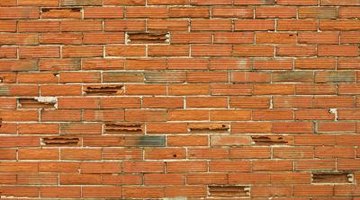Can You Use Brick for Countertops?
Brick use dates back centuries, both as a load-bearing construction material and as a decorative facade. For example, according to London's University College, an ancient race inhabiting the Tigris-Euphrates River was the first to use bricks. Today bricks are a common, cost-effective building product. Brick is even an option for an adventurous do-it-yourself backsplash area for a countertop. Nevertheless, seldom, if ever, is it used as a countertop material.
Porosity

Bricks are high-heat-fired clay and are therefore very porous. This porosity makes bricks an inadequate countertop material. For example, granite and tile countertop materials repel grease and common stains. Brick, on the other hand, does no such thing. Because of its porosity, bricks are very difficult to clean as well.
Roughness
No matter what you do, a brick countertop will be extremely coarse and rough to the touch. Bricks are primarily used as a building product, making them highly durable and load bearing but with the downside of an uneven, jagged surface. Brush your hand over a brick wall to get an idea of just how rough the material is.
Trim
Another downside to using brick for a countertop is that bricks don't have "trim" components. Trim pieces cap and finish off the corners and edges of a countertop. For example, fabricated stone pieces trim natural stone tile countertops. Likewise, ceramic tile countertops feature custom trim pieces or matching trim detail components. Unfortunately, brick trim components are not available; rather the homeowner faces rough, jagged transition edges.
Appropriate Countertop Materials
Ceramic tile is an adequate, affordable countertop material. Granite tiles are durable, impervious to water and stains, stylish and cost effective. The do-it-yourselfer can use decorative tile trim with a granite tile countertop or fabricate the trim.
References
Writer Bio
Residing in San Diego, Calif., Tim Daniel is a professional writer specializing in politics. His work has appeared at both the Daily Caller and Pajamas Media. With more than 20 years of experience in the field of construction, Daniel also specializes in writing about tile, stone and construction management. He is pursuing a bachelor's degree in communications.
Photo Credits
- Photos.com/AbleStock.com/Getty Images
More Articles



